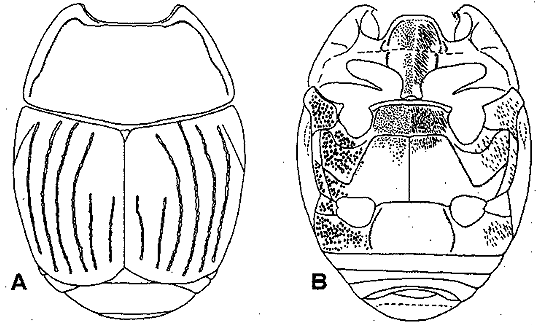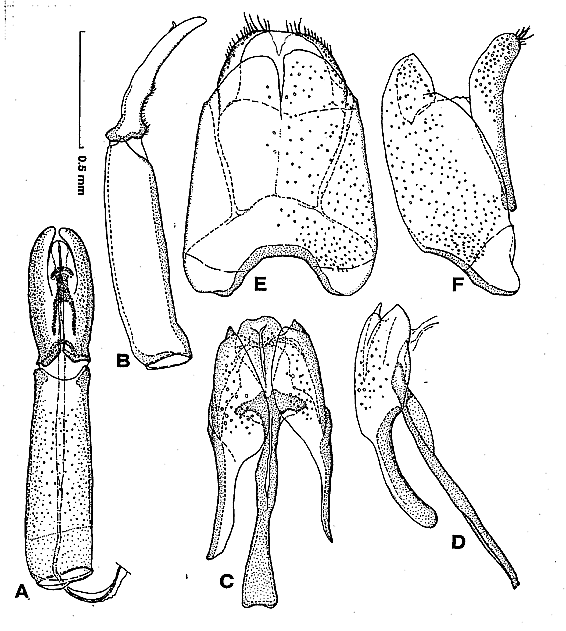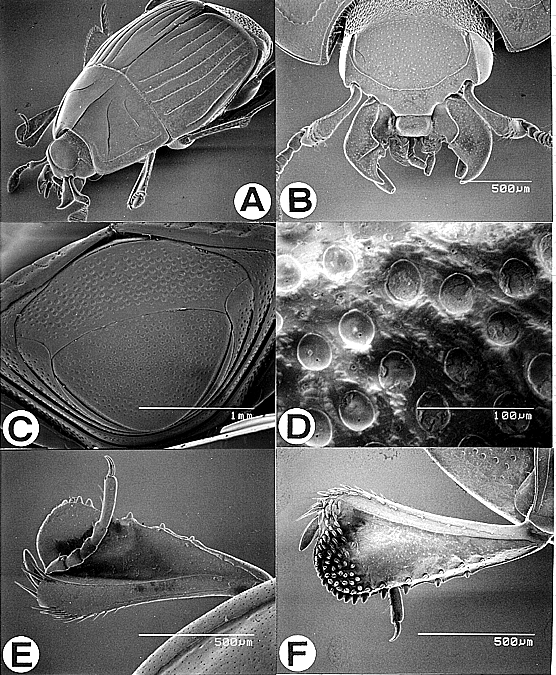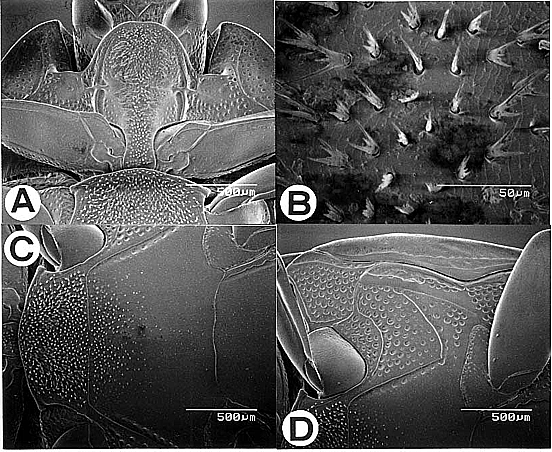
Asiaster calcator Cooman, 1948
Asiaster calcator Cooman, 1948, 124 [Taiwan: Sozan (Holotype), Shinchiku (Paratype)]; Mazur, 1997, 134 [cataloged].
Redescription (Ohara, 1999: Figs. 22-25).
Biometric data as follows (in mm): PPL 4.1, PEL 3.5, APW 1.2, PPW 2.7, PL 1.3, EL 1.85, EW 3.0, ProW 1.7, ProL 0.8, PyL 0.75, PTL 0.95, MSTL 0.9, MTTL 1.4. Body oblong-oval, feebly depressed, black and shining; antennae, mouth parts, tibiae, tarsi and transverse apical band of elytra reddish brown.
Frontal stria of head complete and deeply impressed, regularly arcuate on anterior portion. Disk evenly covered with punctures, which are separated by their own diameter. Labrum transversely oblong.
Marginal pronotal stria interrupted behind head, complete laterally. Inner lateral pronotal stria complete, straight on anterior portion and sinuate at laterobasal third. Disk of pronotum evenly covered with moderate-sized and fine punctures, the moderate-sized ones being separated by about four times their diameter; band along posterior margin coarsely punctate; a short longitudinal impression present in antescutellar area.
Epipleural fossette not excavate. Marginal elytral stria shortened on basal fourth. Marginal epipleural stria complete, carinate and sparsely crenate. External subhumeral stria deeply impressed medially, shortened on basal ninth and apical third. Internal subhumeral stria represented on apical half by a row of coarse and sparse punctures. Oblique humeral stria weakly impressed on basal fourth. First to 4th dorsal striae deeply impressed, complete and crenate; 4th strongly arcuate outwardly. Fifth and sutural striae present on apical half, the sutural inwardly sinuate basally. Surface of elytra evenly covered with moderate sized punctures, which are separated by four to ten times their diameter.
Propygidium irregularly covered with coarse and ocelloid punctures, which are separated by half to three times their diameter; interspace among the coarse punctures sparsely intermingled with fine punctures; disk clothed with strigose ground microsculpture. Pygidium convex medially; punctation similar to that of propygidium, but the punctures much denser and becoming sparser and finer apically.
Prosternal lobe truncate apically, its disk densely covered with coarse punctures, the punctures becoming sparser laterally and furnished with hairs on median area (Fig. 24B), the hairs ramose; marginal stria of lobe interrupted antero-medially and deeply impressed laterally. Prosternal keel flat on the top, the posterior margin angulate inwardly; disk densely and coarsely punctate, the punctures furnished with long hairs; lateral area sparsely and coarsely punctate. Lateral prosternal stria complete, strongly carinate.
Anterior margin of mesosternum (Fig. 24C) outwardly arcuate; marginal stria feebly impressed anteriorly and laterally; disk densely covered with coarse punctures, which are separated by about their own diameter; with yellow hairs. Meso-metasternal suture complete. Lateral stria of metasternum (Fig. 24D) strongly carinate, complete, extending obliquely and posteriorly and united with the oblique stria that extends inwardly from the middle of metasterno-metepisternal suture; post-mesocoxal stria extending laterally and strongly curved anteriorly along the posterior margin of mesocoxa, and attaining to the inner third of metasterno-mesepimeral suture; intercoxal disk depressed and densely and coarsely punctate on basal third, the punctures furnished with rather short hairs and becoming sparser posteriorly and laterally; apical half of the intercoxal disk sparsely covered with fine punctures, which are separated by about five to ten times their diameter; lateral disk densely covered with large punctures, which are separated by one-third to half their diameter and become finer medioapically.
Intercoxal disk of first abdominal sternum completely striate laterally.
Protibia (Fig. 23E, F) with about 18 denticles on outer margin, the apical 14 small and densely set on anterolateral corner; about 30 small denticles present on apical fourth of ventral surface. Profemoral stria complete, straight and feebly carinate. Mesotibia with about 16 spines on outer margin and many spines present on apical corner.
Male genitalia as shown in Fig. 25. Basal piece long; ratio of parameres length to basal length about 0.65.
Specimens examined.
[Proper] Taichung Hsien: Chitou (1 male, 5/viii/1977), native collector.
Distribution. Taiwan.

Fig. 22. Asiaster calcator Cooman. A: Pronotum and elytra. B: Ventral side of adult. [no. 9612, Chitou]. (Ohara, 1999).

Fig. 25. Asiaster calcator Cooman. Male genitalia. A: Aedeagus, dorsal view. B: Ditto, lateral view. C: Ninth and 10th tergites and 9th sternum (spicule), dorsal view. D: Ditto, lateral view. E: Eight tergite and sternum, dorsal view. F: Ditto, lateral view. [no. 9612, Chitou]. (Ohara, 1999).

Fig. 23. Asiaster calcator Cooman. A: Adult, oblique view. B: Head, frontal view. C: Propygidium and pygidium, caudal view. D: Punctation of pygidium. E: Right protibia, dorsal view. F: Ditto, ventral view. [no. 9612, Chitou]. (Ohara, 1999).

Fig. 24. Asiaster calcator Cooman. A: Prosternum and mesosternum, ventral
view. B: Hairs on prosternal process. C: Intercoxal disk between meso- and
metasterna, ventral view. D: Mesosternum, metasternum and epipleura of elytron,
ventral view. [no. 9612, Chitou]. (Ohara, 1999).